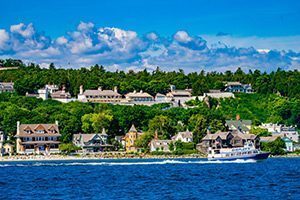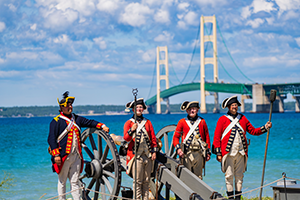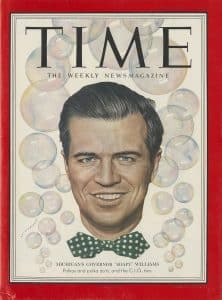

The G. Mennen Williams Mackinac Celebration is the kickoff to the events season for our friends group Mackinac Associates, named in honor of former Governor G. Mennen “Soapy” Williams. But who was Gov. Williams and why is he important to Mackinac State Historic Parks?
Gov. Williams served in Michigan’s highest office for six consecutive two-year terms, making him the winningest gubernatorial candidate in state history. He was first elected in 1948 and served throughout the 1950s until his retirement in 1960, when he did not seek reelection. Gov. Williams and his wife, Nancy whom he married in 1937, are remembered as spending as much time as his schedule would allow at the Governor’s Summer Residence on Mackinac Island. Once out of office, he purchased a home on the West Bluff, called The Pines. This historic cottage is just a few doors down from Grand Hotel, and it is now owned by the Manoogian Foundation. It hosted the 2025 Mackinac Celebration in June.
A Life of Public Service
Born in 1911 to Henry P. Williams and Elma Mennen, Williams spent his childhood in Detroit. His grandfather was Gerhard Heinrich Mennen, founder of the Mennen brand of men’s personal care products, who not only inspired his name, but his nickname, too – Soapy.
The nickname dates back to his adolescence in 1925, as explained by biographer Frank McNaughton in his book “Mennen Williams of Michigan: fighter for progress,” published in 1960. His brothers’ nicknames, Henry “Lather” and Dick “Suds,” did not last. “Not only did Mennen’s ‘Soapy’ stick to him; he had, in fact, seemed to take pride in it,” McNaughton wrote. “Political admirers along parade routes and in meetings hail him as ‘Soapy,’ and his family refers to him as ‘Soapy.’ But his associates in State government and higher levels of politics, except for an occasional slip, refer to him as Mennen or Governor.”
While attending an all-boys preparatory school in Connecticut during his teenage years, Williams became a studious scholar, competent athlete, and prolific poet. He also deepened his morals and Christian faith, serving as Chapel Prefect for three years, and developed a passion for helping the underdog and disadvantaged, which would guide his career in Michigan politics later in life.
“Almost from the times he could think for himself,” McNaughton said, “Williams had a driving compulsion to get into public service, and to work for others in whatever way his conscience told him was best.”
After high school, Williams was admitted to Princeton University, stating in his application that he sought “to be trained as a leader.” During his undergraduate career, he studied in English, Latin, history, physics, economics, Greek, and French. He graduated with an A.B. in history, and after nearly a decade of academic study on the East Coast, he came home to attend the University of Michigan Law School, where his interest in politics took off.
Williams was interested in the federal political reforms of the time. Franklin D. Roosevelt was in the White House and making huge changes via the New Deal program, which included the establishment of Social Security among other initiatives. After graduating with a juris doctor, Williams became an associate attorney for the Social Security Board in Washington D.C. and held other positions with the Department of Justice and other organizations.
When Pearl Harbor was attacked in December 1941 and the United States entered World War II, Williams was called to another line of public service. He joined the Air Force as an intelligence officer and served in Alaska, Hawaii, the Marshall and Marianna Islands, and at sea throughout the Pacific. He earned ten battle stars and was discharged in 1946 at the rank of Lieutenant Commander at age 35.
Politics and a Bowtie
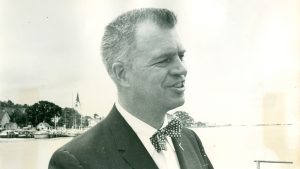

Following the war, Williams returned to Michigan where he took up a post at the Office of Price Administration in Detroit. He became increasingly active in state politics and was appointed to the Liquor Control Commission in 1947.
The Michigan Democratic Party was in a period of flux at this time, as Williams and fellow reformers struggled against the influential union leader James R. “Jimmy” Hoffa of the International Teamsters Union and Victor Bucknell, Hoffa’s pick for governor. After a contentious and difficult campaign, Williams secured the Democratic nomination, and then went on to win the election, beating incumbent Republican Gov. Kim Sigler.


It was on inauguration day that another tradition for Gov. Williams began. In honor of the occasion, his brother, Dick, gave him a green and white polka dot bow tie, which then became his trademark. Mackinac State Historic Parks and Mackinac Associates remember this through our bowtie logo for the Mackinac Celebration.
“His green and white polka dot tie originated as a First Inaugural good luck gift from his brother, Dick,” said McNaughton. “He wore it because he liked it. It soon became a trademark for him. When others later urged him to forego the green bow, Williams refused, saying that it would be out of character for him to abandon his habitual tie.”
A Novel Funding Scheme and Lasting Legacy
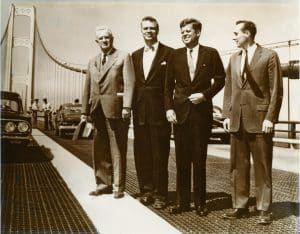

Williams’ time as governor is marked by several major accomplishments, including the creation of the Mackinac Bridge linking Michigan’s peninsulas. Governor Williams oversaw legislation to re-establish the Mackinac Bridge Authority (which had been abandoned because the project was deemed unfeasible for a time) and shepherded the legislation to finance and construct the bridge.
During an address to the Michigan Bankers Association held at Grand Hotel on Mackinac Island in June 1954, Williams outlined the difficult and complicated process of securing about $100 million for the bridge construction by selling bonds to the public, which earned a 5% yield for purchasers, a rate lower than high-interest loans. With this financing source secured, the bridge eventually became reality, opening in November 1957.
In 1958, the Mackinac Island State Park Commission began a similar campaign to start their own revenue bond program to finance the preservation and development of Mackinac State Historic Parks sites. Gov. Williams was supportive of the idea and brought together local leaders, historians, and politicians to make the program a reality. This allowed Mackinac State Historic Parks to begin its professional museum, educational, and preservation work. The bonds are now retired, and museum operating costs are primarily paid from admission revenues and the proceeds of publication and museum store sales. The revenue bond program has created one of the most visited history museum complexes in the nation, with nearly 400,000 visitors each season.


Williams served six consecutive two-year terms as Michigan’s governor from 1948 to 1961. The term of office was lengthened to four years beginning in 1967, following the adoption of the Michigan Constitution in 1963. Governors could serve an unlimited number of terms until voters adopted term limits in 1992, limiting to two terms. Former governor John Engler was the last to serve more than two terms, having been first elected in 1990, before the amendment of the state constitution went into effect.
Following his time as governor, Williams was appointed as Secretary of State for African Affairs for five years. Williams also served as the United States Ambassador to the Philippines from 1968 to 1969. After his return to the United States in 1970, he was elected to the Michigan Supreme Court where he served until 1987.
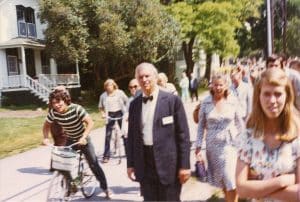

Even after his tenure as Michigan’s governor ended, Williams continued to spend time on Mackinac Island. He owned property on the West Bluff and continued to be active in the community. Williams passed away in 1988 and is buried in the Protestant Cemetery on Mackinac.

